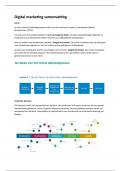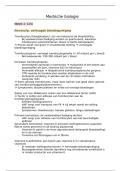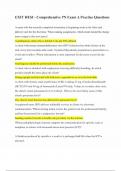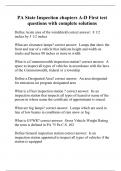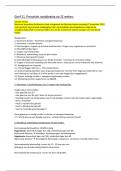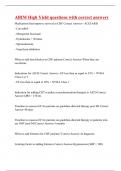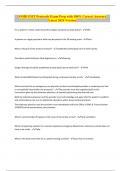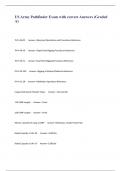CONSUMER PSYCHOLOGY
1. INTRODUCTION
Consumer psychology = all behaviors that relate to people as consumers
→ we zullen veel studies zien die uitleggen hoe consumenten een beslissing maken. Voorbeeld: grzond vs.
Ongezond eten: wat gaat er in het brein om die tot deze keuze heeft geleid?
→ andere dingen zoals hoe campagnes kunnen worden omgezet met advertenties zoals bijvoorbeeld ‘gele
tanden’ en er is ineens een product waarmee je witte tanden kan krijgen. Het werkt nog altijd want mensen
worden nog steeds beönvloed ook al weten ze dat het te mooi is om waar te zijn.
→ keuzes maken in supermarkten: hoe maken we keuzes tussen welke merken we kiezen? En in welke
gevallen mensen geneigd zijn om naar hun favoriete merk te gaan en wat zorgt ervoor dat mensen hiervan
gaan uitwijken?
→ voorbeeld: je bent de brand manager van Lays: ze willen meer doen dan alleen paprika en zout en voor hen
is het heel interessant om na te denken wanneer consumenten geneigd zijn andere smaken te kiezen en dat dit
misschien te maken heeft met de mood waarin mensen zijn. Dit resultaat is de uitkomst van een experiment
naar gemoedstoestand.
• What makes them like/choose/buy? → emotions, rational behavior? Choice process? Situational
influences? → voorbeeld: kopen mensen meer loterij tickets bij goed of slecht weer? Wanneer het
donkerder weer is, kopen mensen meer loterij tickets. Dit is een situational influence die een impact
kan hebben op de keuze die mensen maken.
• How do consumers deal with persuasion attempts? → influence, resistance, young consumers… → als
veel mensen iets doen dan zal het wel goed zijn. Voorbeeld: in corona heeft de ovehreid geprobeerd
om iedereen te overtuigen om een vaccin te halen maar ze wisten dat mensen tot op een bepaald
punt zich wel gingen afvragen ‘waarom hebben we dat nodig?’ op zo’n moment moeten ze een
strategie vinden om deze afkeer te overbruggen
• Psychological methods (experiments), focus on (underlying) processes of attitudes & behavior (and
individual differences or other moderators) → gender: reageren mannen anders dan vrouwen? Je kan
gender als een moderator nemen. Het zou kunnen dat karakteristieken ook een invloed hebben per
persoon.
2. CONSUMER INFORMATION PROCESSING
→ het is niet omdat je vergeet welke reclame je gezien hebt dat het geen effect of impact heeft op ons
• How do they process (consumer-related) stimuli?
• Information overload (home, media, shops, other people)
• How does this affect their attitudes, and behavior?
, Het is een lineaire manier om om te gaan met persuasive
communication maar dit model is niet in staat om de omgeving er bij
te betrekken. Het is alleen in staat om ‘de top van de ijsberg’ te
betrekken maar geen achetrliggende omstandigheden.
• Cognitive resources are limited:
o Mental muscle: it has to work and work
o Depletion: it gets too tired and exhausted. If we’re in this state it also affects how we deal in
the environment
o Mental shortcuts
1) Exposure: it refers to the process by which consumers encounter information about products or
services
2) Attention: it’s the process by which consumers focus their mental resources on a particular stimulus
or information. Consumers choose to pay attention to certain stimuli while ignoring others.
3) Comprehension: how consumers understand and interpret information about products or brands. It
affects consumers’ decision-making-processes.
4) Acceptance: consumers form attitudes and opinions about the product or service based on the
information they have comprehended
5) Retention: after accepting the information, consumers store it in their memory for future reference,
retention is influenced by factors such as the consumers’ level of motivation and involvement, the
repetition of the message…
→ we are less likely to resist impulsive/emotional purchases when we are tired/in the evening.
→ we tend to buy more trivial things when we don’t use a shopping list because our brain gets tired of
searching for the products so at the end of the shopping trip it’s depleted so you’re prone to marketing
strategies.
2.1. MERE EXPOSURE EFFECT ZAJONC (1980)
• Zajonc: preferences need no inferences → Zajonc is een psycholoog die bekend staat om zijn
onderzoek naar emotie en cognitie
• Showed ‘Chinese signs’: participants were exposed to Chinese characters either once, twice, several
times, or not at all. After the exposure, participants were asked to rate how much they liked each
character. The results showed that participants rated the characters that they were exposed to more
frequently as more likable than the ones they were not exposed to.
• Tachistoscope (subconscious): exposing people to those stimuli below the level of conscious
processing (just in a few milliseconds) → Tachistoscope is een techniek die wordt gebruikt in de
psychologie en de neurowetenschappen om visuele stimuli op een zeer korte tijdsduur aan te bieden
aan deelnemers. Het wordt vaak gebruikt om de verwerkingsnelheid en het vermogen van het brein
om informatie te verwerken te meten.
• Outcome: repeated exposure leads to liking
• Applied to advertising: incidental processing = when people read a newspaper, the ads are in their
peripheral processing SO subconsciously they see the brands and are even liked better afterwards,
even though they didn’t really read the ads
,2.2. PERSUASION HEURISTICS
science of persuasion (Cialdini)
Cialdini’s research on persuasion has identified six key principles that influence people’s decision making:
1. Reciprocity: people feel obligated to return favors or concessions when someone has done something
for them. This principle emphasizes the importance of giving before asking for something in return.
2. Scarcity: people perceive things that are rare of limited in availability as more valuable. Creating a
sense of scarcity can make people more motivated to take action.
3. Authority: people tend to follow and trust those who are perceived as credible and knowledgeable in
a particular field. Establishing authority can enhance persuasion.
4. Consistency: people have a desire to be consistent with their past beliefs, and actions. By aligning
persuasive messages with individuals’ existing beliefs or commitments, persuasion can be more
effective.
5. Liking: people are more likely to be influenced by those they like and find attractive. Building rapport
and establishing a connection can increase the chances of successful persuasion.
6. Consensus (social proof): people are heavily influenced by the actions and behaviors of others,
especially in uncertain or ambiguous situations. Demonstrating that others have taken a particular
action can lead to increased persuasion.
FOR COMMUNICATION SCIENTISTS
Insights in consumer behavior are important for the following professors:
• Strategic planner in advertising agency
• Market research companies
• Store design
• Health communication
• Social marketing
• Politics & political campaigning + communication
3. INDIVIDUAL DIFFERENCES
→ if you consider designing your own experiment: people differ on a lot of aspects, every person is different.
It’s important to think whether individual differences could matter to what you’re going to investigate. In that
sense, these differences become moderators in your design. A moderator means that the effect that you
expect differs from where people are in their life. Some people are better at controlling their behavior then
others. You could include that in your study. The moderators are endless.
Important moderators!! Better insights in consumer psychology processes
• Sociodemo’s: age, gender, cultural differences
• Behavioral patterns: e.g., restrained eating (1), disgust sensitivity (2) → are you on a diet yes, or no?
people who are on a diet probably react differently to food advertising, or in a restaurant or
supermarket. On the other hand, people with high disgust sensitivity are more likely to experience
intense feelings of disgust and may be more avoidant or potentially disgusting situations of objects.
This sensitivity can vary among individuals and is influenced by factors such as personal experiences,
cultural norms, and individual personality traits. It measures the degree to which you are easily
disgusted or not: these can be very stable ones like your personality but also more situational ones.
, • Personality traits
o Need for cognition → how does cognition plays a role when we must deal with incoming
persuasive stimuli: the degree which you enjoy thinking.
▪ = the tendency for an individual to engage in and enjoy thinking
▪ I would prefer complex to simple problems.
▪ Thinking is not my idea of fun.
▪ I prefer my life to be filles with puzzles that I must solve.
High NFC show greater elaboration of message content compared to low NFC →
people with a high NGC are more likely to enjoy activities that require mental
stimulation and may spend more time engaged in tasks that involve thinking,
reasoning and evaluation information. They often have a strong desire to
understand complex subjects and are motivated to seek out challenging mental
activities.
o Prevention/promotion → regulatory focus
▪ = chronic disposition toward prevention/ promotion
▪ Can also be induces situationally (state)
▪ Promotion-oriented people prefer gain frames and prevention-oriented people
prefer loss frames. → a lot of questions are based on what you were like as a kid of
what situations you were in as a kid
▪ Promotion focus: characterized by a motivation to approach positive outcomes and
a desire for growth and advancement. People tend to be more eager, driven and
willing to take risks to achieve their desired goals. They focus on attaining gains,
accomplishments and aspirations.
▪ Prevention focus: characterized by a motivation to avoid negative outcomes and a
desire for safety and security, tend to be more cautious, vigilant and focused on
preventing losses and mistakes. They prioritize maintaining stability, avoiding errors,
and fulfilling their duties and responsibilities.
o Personality scales (big 5)
▪ Stable psychical characteristics, unique for every human being, but can reveal
underlying traits → biometric variables refer to physical or psychological
characteristics or measurements of living organisms, these variables are often used
in biological and medical research to study and understand the variation and
relationships among individuals, species or populations.
▪ Still understudies in CP
These are all scales!!
BEHAVIORAL PATTERNS
(1) Restrained eating: if you’re on a diet, you’re always thinking about what you can or can’t eat so you’re
more easily depleted and as a result more vulnerable to impulse buying
(2) Disgust sensitivity: measures the degree in which you are easily disgusted: if it’s high, you’re less likely
to be influenced because you will avoid more things
(3) The ration of your digits says something about you: if your index finger is shorter than your ring finger
(= low 2D:4D), you have more prenatal testosterone exposure (man) so more aggressive reactions
towards aggressive music, better at playing soccer…





